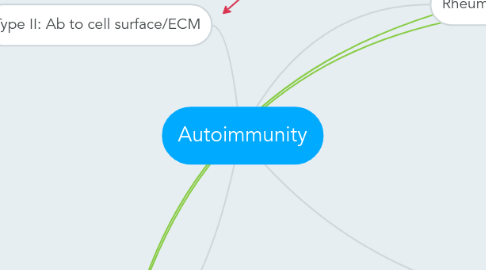
1. Type II: Ab to cell surface/ECM
1.1. Direct Coomb's and C1
1.1.1. hemolytic anemia
1.2. anti-GP2a/3b and vWF cleaver
1.2.1. Idiopathic Thrombocytopenic Purpura
1.3. anti-desmoglein
1.3.1. blistering
1.3.1.1. Pemphigus vulgaris
1.4. TSHR agonist
1.4.1. Bulging eye syndrome
1.4.1.1. Grave's disease
1.5. anti-AChR
1.5.1. diplopia and ptosis
1.5.1.1. Myasthenia gravis
1.6. Molecular mimicry
1.6.1. Group A strep. to heart
1.6.1.1. Rheumatic fever
1.6.2. Campylobacter jejuni to gangliosides(myelin)
1.6.2.1. ascending symmetrical weakness of limbs
1.6.2.1.1. Guillain Barre Syndrome
1.6.3. after infection - neutrophil cytoplasm (ANCA)
1.6.3.1. rhinitis and conjunctivitis
1.6.3.1.1. Granulomatosis with Polyangitis
2. Type IV: T-cell
2.1. CD8 to Beta cells of Pancreas
2.1.1. T1DM
2.2. Th1 to myelin - IgG in CSF
2.2.1. progressive muscle weakness; loss of coordination
2.2.1.1. Multiple Sclerosis
3. Rheumatic disorders (ANA)
3.1. topoisomerase(anti-Sci70) and centromere(ACA)
3.1.1. Thick, ivory skin
3.1.1.1. IgG to vasculature
3.1.1.1.1. Scleroderma
3.2. anti-CCP
3.2.1. RA
3.3. anti-Ro/SS-A or anti-La/SS-B
3.3.1. dry mucosa
3.3.1.1. Sjorgen's Syndrome
3.4. anti-cardiolipin or anti-glycoprotein
3.4.1. thrombosis
3.4.1.1. false positive syphilis test
3.4.1.1.1. APLS
3.5. Anti-dsDNA, anti-Smith, self-macromolecules
3.5.1. SLE
4. Type III: Immune Complex (reduced C1)
4.1. cryoglobulin/Bence Jones protein - like RF
4.1.1. Mixed essential cryoglobulinemia
4.2. IgG to S.Viridians in heart
4.2.1. Subacute Bacterial Endocarditis
